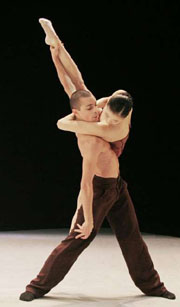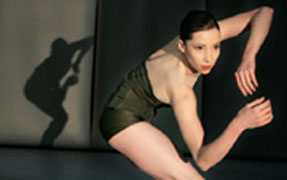
Jack Anderson
Two Second Companies
American Ballet Theatre II
Gerald W. Lynch Theater at John Jay College
April 3-4, 2009 (closed)
Nederlands Dans Theater II
Joyce Theater, April 9-12, 2009 (closed)
Reviewed by Jack Anderson, April 14, 2009
 |
| "Sleepless." Photo by Joris-Jan Bos Photography. |
More and more big companies are spawning little ones, and the little ones keep growing. It has become increasingly common for dance groups to establish "second companies" as training institutes for young dancers. Although some little groups remain workshops, others expand, not necessarily in numbers of dancers, but in ambition and repertories, often performing and touring as independent entities. Two of the ballet world's most successful such enterprises, American Ballet Theatre's ABT II (directed by Wes Chapman) and Nederlands Dans Theater II (directed by Gerald Tibbs and often referred to as NDT II), gave some fascinating performances here.
Youthful energy warms the heart, and youthful attractiveness gladdens the eye. But these youngsters were more than good-looking: they were surprisingly confident and agile, capable of doing anything choreographers might wish. No wonder their companies put them in ballets filled with steps. Lots of steps. Surfeits of steps.
But that was the trouble. Too many steps appeared to exist for no purpose relating to theme, emotion, or visual design. They were just physical displays.
Three of NDT II's four presentations were by the choreographic duo of Paul Lightfoot and Sol León (collectively known as Lightfoot León), who must be infatuated with tricky steps. Trickiness acquired genuine significance in "Shutters Shut," in which Caroline Mancuso and Idan Sharabi had fits of wiggles to a recording of Gertrude Stein reciting one of her poems. Like many Stein texts, it had minimal literal sense, but considerable rhythmic verve, and the way the dancers' physical motions complemented the verbal rhythms made the duet delicious choreographic nonsense, a sort of kinetic tongue-twister. "Shutters Shut" has been seen in New York before; it was worth seeing again.
The other Lightfoot León ballets were less rewarding. "Sad Case" presented relentless puppet-like jerks and shakes to recorded Latin music. "Said and Done," to Bach, began powerfully as four strong men hurtled about, as if abandoning themselves to the force of a toccata and fugue. But then, as a man stood looking glum amid falling leaves, couples danced complicated duets that left everyone in states of vague unmotivated melancholy.
 |
| Sleepless Jiri Kylian. Photo by Sarah Reynolds Joris-Jan Bos Photography. |
Jiri Kylián, NDT's most justifiably celebrated choreographer, was represented by "Sleepless," to a Dirk Haubrich score based on a Mozart adagio. Like "Said and Done," it began well. The stage was backed by fabric panels with slits in them through which dancers came and went while gigantic shadows loomed across the panels' surfaces. Kylián thereby created a sense of disquieting insomniac passing fancies. But mystery soon dissipated in an excess of restless and monotonous steps.
ABT II's infatuation with steps was apparent in Jodie Gates's "A Taste of Sweet Velvet," to the molto vivace movement of Beethoven's Symphony No.9, which sent dancers rushing, sometimes to downstage center, sometimes to the sides of the stage. Gates's choreography, like Beethoven's music, had many sudden little starts and stops. But Gates was not content with what Beethoven provided, for Jack Eddy contrived a "musical landscape" that intensified these sonic interruptions and made the choreographic phrases to them look distorted. One tinkers with Beethoven at one's peril.
Other ballets were less frenetic. Aszure Barton's "Barbara" matched songs by the singer of that name with casual-looking, amiably danced, choreography. Two familiar pas de deux emphasized the young dancers' classical training. Jaime Hickey and Calvin Royal III did not appear especially enamored as Prince and Swan Queen in the adagio from the second act of "Swan Lake." Nevertheless, their performance was admirably unmannered. Meaghan Hinkis and Alberto Velasquez sailed through the "Don Quxote" pas de deux with bravado; Hinkis's turns were especially dazzling, and both dancers have mastered the art of balance.
Best of all was "Interplay," Jerome Robbins's romp of 1945. The cast's slight self-consciousness suggested that the jazziness of the 1940's is no longer second-nature to today's dancers, yet they preserved Robbins's choreographic good humor. Although his steps are always clever, there are never too many of them: Robbins knew how to give audiences just enough.
| museums | NYTW mail | recordings | coupons | publications | classified |
